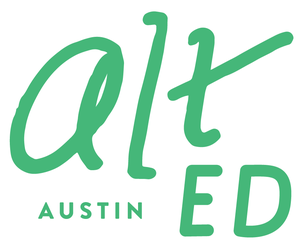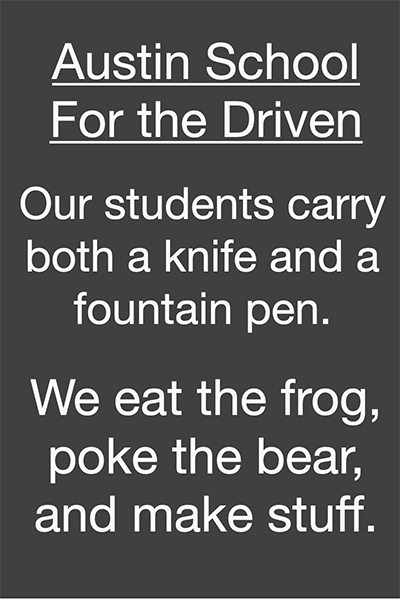Game of Village
/My work at Alt Ed Austin includes visiting lots of great innovative schools and enrichment programs and getting to see some beautiful ideas in action. There’s no program I love more than Game of Village, so we’re thrilled to have Village director and consultant Cheryl Kruckeberg join us on the blog for a show-and-tell about its educational benefits and sheer delights. Read on to learn how you can get your kids signed up for Village this month!
Village is about Play.
Play stretches the imagination,
and imagination can lead us to
whatever and wherever we want to go.
Throughout history, children have prepared for their adult lives by observing and modeling the activities of the adults around them. They imagine, pretend, and practice, and through these activities they gain understanding, stretch their capacities, and explore new concepts and ideas. In play children are released from the constraints imposed by a fear of failure and are left free to experiment. In short, they grow! Play is, in fact, a natural and powerful way to learn, and Village is all about play!
Each game of Village is set in a particular geographical location and time period. It starts with the bare bones of a story line: some challenge to be faced, a problem to be solved, or obstacles to overcome. From this loose outline and the fertile imaginations of the players a world emerges.
Village is played on two integrated levels. On a 1/24 scale the players, known as “Villagers,” design and build a complete village. This aspect of the game includes a “Peep,” a 3" avatar, with an independent personality, life story, and hopes and dreams.
Peeps want a home; Villagers design it for them. Peeps want a piece of land on which to place their fine homes; Villagers get that for them as well! Peeps like party hats, rocket ships, furniture, and social gatherings. (Some of them, like the unique character below, enjoy hammocks, too.) They become embroiled in scandal and drama! There are weddings, fundraisers, funerals, kidnappings, and robberies.
Fulfilling the demands of the Peeps and keeping up with their antics keeps Villagers pretty busy. Using their Peeps’ home design and land as collateral, and inspired by the needs and wants of the Peeps, Villagers head off to the Village bank to secure a loan and begin making purchases for their many new projects. And here begins the second aspect of the game.
Now the Villagers are running their own dynamic community. With money in hand, they go to the Trading Post to purchase all manner of goods for building their Peep homes, general crafting, and various independent enterprises. Villagers open businesses; apply for jobs at the bank, trading post, newspaper, or post office; run for government office; or perhaps attend the Village University. There are many ways for Villagers to earn income and stay busy!
Money and time management and goal setting become important: some Villagers accumulate wealth, others overdraw their bank accounts. Will the Villagers form a government? If they do, will that government be ethical and trustworthy or crooked and out for personal gain? Will laws be needed to keep the peace and ensure that all are treated fairly? The Villagers themselves will determine all of this and more. As in real life, there are model citizens, civil servants, bakers, and artists—as well as scoundrels, loafers, and ne'er-do-wells. It's all learning and all valuable! The possibilities are endless, and the game takes a new turn each time it is played.
From designing and building the scale model village for the Peeps, to managing personal projects and jobs, to attending to civic matters and the myriad interpersonal issues that always arise where groups of people converge, Village is filled with valuable, real life learning. Village is dynamic, unpredictable, and messy. It's challenging, rewarding, and fun! Village, like life, is filled with unforeseen circumstances and opportunities and, although children may play it over and over again, it is never the same and never loses its appeal. Village is filled with peer-based learning, natural consequences, and “Aha!” moments. In Village, young people step into leadership, confront real problems, and collaborate to find creative solutions. They take on the world, and they do an admirable job of it!
As a teacher, mentor, and school director of 40+ years, I can confidently say that Village is the most powerful teaching tool I have ever encountered, and it has completely transformed my understanding of learning and teaching. Most importantly, it has transformed and vastly expanded my view of what young people are capable of. Village has provided me a platform from which to explore and teach applied academics in a meaningful context. I have learned to trust the natural learning process and have grown comfortable with the chaos and mayhem that can come with letting creativity, self-expression, and learning by experience take reign, rather than imparting knowledge in a controlled learning environment. Moreover, Village has brought the spirit of play, creativity, and trust back into my own adult life. Village has become my passion, and it's my goal to share it with as many young people and mentors as I can!
Village takes roughly 25 days from start to finish. It has been played as the central component of an integrated, academic school curriculum, with homeschool groups, and as summer camps. It is best played with 20–26 (or so) children, aged 9–14 years (or so). However, Village, like life, can be adapted to a wide array of circumstances and needs.
For the past 10 years Village has been the heart of the Austin EcoSchool/Village Academy curriculum. With the recent closing of this wonderful school, Village is now loose; unfettered by a brick and mortar location, Village is free to come to you!
If you would like to register your child in an existing Village program or are interested in bringing Village to your child’s learning community, please contact us at play@gameofvillageaustin.org.
A Friday Village program is starting at AHB Community School on January 6, 2017, and is open to the homeschool community. Applications are accepted through mid-January. We are also in the process of launching a Summer Village, complete details of which will be available soon.
You can keep up with VillageinAustin by liking us on Facebook. Or read much more about us on the new Game of Village Austin website.
Cheryl Kruckeberg
























